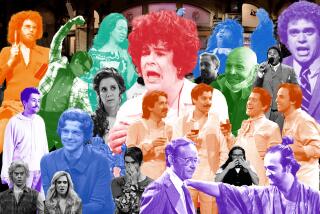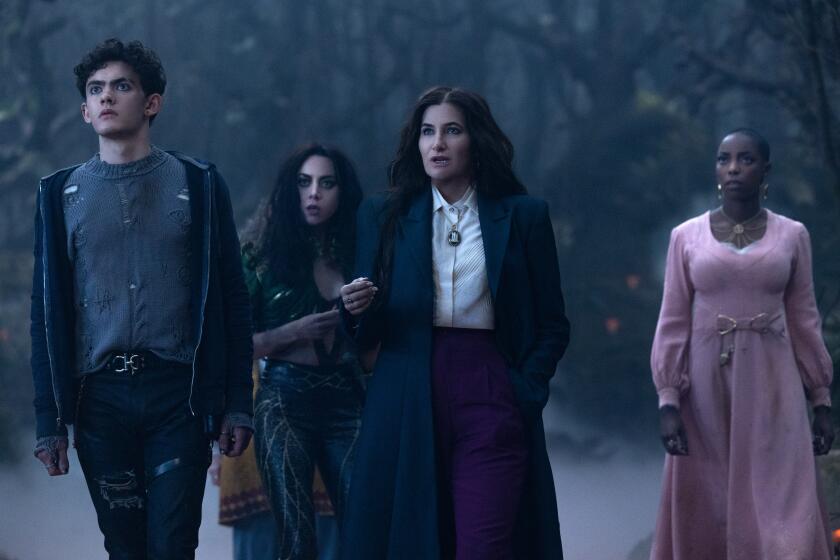SOMETIMES PRISON <i> IS</i> A PRETTY PICTURE : Santa Ana Exhibit Shows Works of California Inmates Who Let Their Artistic Sides Run Free
There’s a scene in “American Me,” Edward James Olmos’ movie about Latino prison life, that shows a new inmate immediately entering the top of the gang’s hierarchy.
It helps that he’s the younger brother of an already powerful member, but what really sets him up is a talent with tattoos. He’s an artist, someone who can turn imagination into reality, and that commands respect.
The passage is not just Hollywood play-acting, according to Carol Newborg, a sculptor who has taught art classes in California’s prisons for several years as part of the Department of Corrections’ Arts-in-Corrections outreach program for both male and female inmates.
“The creative process, the making of art, is very important; it carries weight,” she said. “A drawing might be used to trade for cigarettes or whatever. Art has much value inside.”
Prison art, the paintings, drawings, ceramics and other disciplines, compose “Realities: Yard Art/Schooled Art” at the Orange County Center for Contemporary Art in Santa Ana. The exhibit, continuing through May 22 and featuring more than 50 pieces from institutions like San Quentin and Folsom, is meant to testify, say organizers, to art’s ability to flourish in even the harshest environments and its legitimacy as a tool in rehabilitation.
“The idea is that it can help people to see alternatives,” said Newborg, who helped organize the show. “We believe that art is healing. Given the opportunity to explore a side of oneself, you can build self-esteem. Art helps prisoners find things in life that they didn’t know were there.”
To support that argument, Newborg pointed to corrections department studies showing that inmates participating in art programs are involved in fewer violent incidents within the institutions and tend to have a lower rate of recidivism. A few, including Cruz, one of the exhibit’s featured painters, go on to fruitful art careers once outside, Newborg added.
“I’ve stayed in contact, informally, with several of those I’ve taught, and the big thing is that they tend to continue their art. The biggest thing is that they tend to stay out of prison, for whatever reason.”
As for the exhibit itself, Newborg conceded that the range of quality is wide, with certain pieces being sophisticated and others more primitive. But what connects them, she said, is the “intensity, sincerity and honesty” behind the vision.
That honesty, apparently, can be cathartic. In trying to explain his acrylic painting “Birth Defect,” Cruz offers this starting point: “I am a neo-mystic painter. The work you see before you is an excrement of my soul, a birth defect.”
The piece, one of the show’s largest, is a panorama of distended, even gutted bodies, a cross between Hieronymus Bosch and Francis Bacon. If Cruz is relating his personal experiences, they must be read as violent and painful.
One of the most rudimentary works is D. Moore’s “Compton, Stop the Gangs,” a simple drawing bearing such inscriptions as “Home of the Body Bag” and “Fear of a Black Planet.” Like Cruz’s painting, the inspiration is pure conflict.
Most of the pieces, though, are more innocently, even naively, visionary. Several inmates reveal flights of fancy, the dreams of places away from prison, in either their imaginations or memories.
Gabriel, a Folsom prisoner, describes a desert scene where men break a wild mustang in his detailed pencil drawing, “Saddling a Bronk.” In “Shadow Ridge,” Jones depicts an idyllic mountain range, crowned by a pair of birds in flight.
At times, the level of technical expertise is remarkable. Folsom prisoner George Brown’s pastel drawing, “Time Out,” is near-photographic in its depiction of a lone tiger resting in the woods. In the area of ceramics, Alois B. Kayse’s three glazed flutes are delicately graceful, and Linda Fields’ “Grey Crochet Basket” is a beautifully crafted piece.
From there, you move to the more crude portraiture, both in pencil and paint (Warren’s flat “Candy Confirmed” and Patricio Chavez’s one-dimensional “Marie” are good examples) that lack stylistic integrity but seem in tune with the intent of Arts-in-Corrections. They don’t reveal artistic greatness, but they do show artistic appreciation and the self-expression that comes from it.
What: “Realities: Yard Art/Schooled Art.”
When: Wednesday through Sunday, 11 a.m. to 4 pm., through May 22.
Where: Orange County Center for Contemporary Art, 3621 W. MacArthur Blvd., Santa Ana.
Whereabouts: Take the San Diego (405) Freeway to Harbor Boulevard and head north. Go east on MacArthur Boulevard.
Wherewithal: Free (donations accepted).
Where to call: (714) 549-4989.
More to Read
The biggest entertainment stories
Get our big stories about Hollywood, film, television, music, arts, culture and more right in your inbox as soon as they publish.
You may occasionally receive promotional content from the Los Angeles Times.










